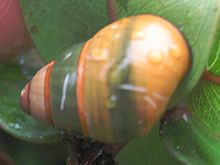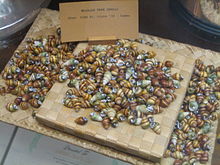- O'ahu tree snail
-
Oʻahu tree snail 
Achatinella bulimoides 
Achatinella lila Scientific classification Kingdom: Animalia Phylum: Mollusca Class: Gastropoda (unranked): clade Heterobranchia
clade Euthyneura
clade Panpulmonata
clade Eupulmonata
clade Stylommatophora
clade OrthurethraSuperfamily: Achatinelloidea Family: Achatinellidae Subfamily: Achatinellinae Genus: Achatinella
Swainson, 1828Species See text
Oʻahu tree snails, genus Achatinella, are a large genus of colorful, tropical, tree-living, air-breathing, land snails, arboreal pulmonate gastropod mollusks in the family Achatinellidae.
This genus of tree snails live in Hawaii, and all are endangered species. They were once abundant. They were mentioned in Hawaiian folklore and songs, and their shells were used in lei and other ornaments.
Many of these arboreal snails are sinistral or left-handed in their spiral shell coiling, whereas most gastropod shells are dextral. (See the section on chirality in the article gastropod shell.)
Contents
Distribution
There are 40 species[1] of Oʻahu tree snail endemic to Hawaiian island of O`ahu. About hundred of each specie is left.
Conservation status
All 40 species are listed under United States federal legislation as endangered. The IUCN lists a number of these species as extinct and the remainder as critically endangered.
O'ahu tree snail shells collected ca. 1933 at an elevation of 1500 feet on Waialae Ridge in Waialae Country Club, Honolulu, Hawaii.
Shell description
Oʻahu tree snails are diverse in patterns, colors, and shapes, but all average about 0.75 in (1.9 cm) in length. Most have smooth glossy, and oblong or ovate shells which show a variety of colors, including yellow, orange, red, brown, green, gray, black, and white.
There are three recognized subgenera within the genus Achatinella.[1] Subnenera are distinguished according to shells characteristics only.
Genus Achatinella Swainson, 1828: The dextral or sinistral shell is imperforate or minutely perforate, oblong, ovate or globose-conic; smooth or longitudinally corrugated, with only weak traces of spiral sculpture. Shell color is in spiral bands or streaks in the direction of the growth lines. The lip is simple or thickened within and sometimes slightly expanding. The columella bears a strong callous fold. Type species of the genus Achatinella is Achatinella apexfulva (Dixon).[1]
Subgenus Bulimella Pfeiffer, 1854: Shell shape is oblong-conic or ovate. The spire is obtuse, rounded or convexly-conic near the apex. The outer lip is thickened by a strong callous rib within the aperture (except in Achatinella abbreviata and Achatinella lila). Type species of the subgenus Bulimella is Achatinella byronii Newcomb.[1]
Subgenus Achatinellastrum Pfeiffer, 1854: The shell is imperforate, ovate-conic or oblong-conic and smooth. The embryonic whorls are not flattened. The outer lip is thin or only slightly thickened within the apex but not expanded. These are the most generally distributed of the Achatinella species and show a prolific area of intergrading color patterns. Type species of the subgenus Achatinellastrum is Achatinella stewartii (Green, 1827).[1]
Ecology
Habitat
These snails live in trees. Currently they are only found in mountainous dry to moist forests and shrublands above 1,300 ft (400 m).
Feeding
These tree snails are nocturnal, and feed by grazing fungus which grows on the surface of native plant leaves.
Although these tree snails are occasionally found on introduced plants, it is unknown whether or not the fungus which grows on these plants can provide long-term support for healthy breeding populations of these snails.
In captivity Achatinella feed on fungus growing on leaves of Metrosideros polymorpha. They also feed on cornstarch, which can be spread in terraria with water and on cultures of sooty mold grown on laboratory agar. In captivity, cuttlebone is used as a source for calcium.[1]
Life cycle
Adult snails are hermaphroditic (having both male and female reproductive organs) and can live for many years. These are live bearing snails (give birth to live snails instead of laying eggs).
Predation and other threats
Because growth rate and fertility are very low, these snails are especially vulnerable to loss of individuals through human collection, through predation, or because of other disturbances.
The most serious threats to the survival of Oʻahu tree snails are predation by the introduced carnivorous snail Euglandina rosea, predation by rats, and loss of habitat due to the spread of non-native vegetation into higher elevation forests.
Species
There are 40 species in the genus Achatinella[1]:
subgenus Achatinella
- Achatinella apexfulva (Dixon, 1789)
- Achatinella cestus Newcomb, 1853
- Achatinella concavospira Pfeiffer, 1859
- Achatinella decora (Férussac, 1821) - extinct
- Achatinella leucorraphe (Gulick, 1873)
- Achatinella lorata Férussac, 1824
- Achatinella mustelina Mighels, 1845
- Achatinella swiftii Newcomb, 1853
- Achatinella turgida Newcomb, 1853
- Achatinella valida Pfeiffer, 1855 - extinct
- Achatinella vittata Reeve, 1850
subgenus Bulimella
- Achatinella abbreviata Reeve, 1850 - extinct
- Achatinella bulimoides Swainson, 1828
- Achatinella byronii (Wood, 1828)
- Achatinella decipiens Newcomb, 1854
- Achatinella fuscobasis (E. A. Smith, 1873)
- Achatinella lila Pilsbry, 1914
- Achatinella pulcherrima Swainson, 1828
- Achatinella pupukanioe Pilsbry & Cooke, 1914
- Achatinella sowerbyana Pfeiffer, 1855
- Achatinella taeniolata Pfeiffer, 1846
- Achatinella viridans Mighels, 1845
- Achatinella elegans Newcomb, 1853 - extinct
subgenus Achatinellastrum
- Achatinella bellula E. A. Smith, 1873
- Achatinella buddii Newcomb, 1853 - extinct
- Achatinella casta Newcomb, 1853 - extinct
- Achatinella caesia Gulick, 1858 - extinct
- Achatinella curta Newcomb, 1853
- Achatinella dimorpha Gulick, 1858 - extinct
- Achatinella fulgens Newcomb, 1853
- Achatinella juddii Baldwin, 1895 - extinct
- Achatinella juncea Gulick, 1856 - extinct
- Achatinella lehuiensis E. A. Smith, 1873 - extinct
- Achatinella livida Swainson, 1828 - extinct
- Achatinella papyracea Gulick, 1856 - extinct
- Achatinella phaeozona Gulick, 1856
- Achatinella spaldingi Pilsbry & Cooke, 1914 - extinct
- Achatinella stewartii (Green, 1827)
- Achatinella thaanumi Pilsbry & Cooke, 1914 - extinct
- Achatinella vulpina (Férussac, 1824)
References
This article incorporates public domain text (a public domain work of the United States Government) from reference.[1] [2] [3] [4]
- ^ a b c d e f g h U.S. Fish and Wildlife Service. (1992) Endangered Species Recovery Plan for the O’ahu Tree Snails of the Genus Achatinella. U.S. Fish and Wildlife Service, Portland, Oregon, 64 pp. + 64 pp. of appendices + 5 figures. PDF
- ^ Holland, B.S. & M.G. Hadfield. 2007. Molecular systematics of the endangered O‘ahu tree snail Achatinella mustelina (Mighels 1845): Synonymization of subspecies and estimation of gene flow between chiral morphs. Pacific Science, 61(1): 53-66.
- ^ Holland, B.S. & M.G. Hadfield. 2004. Origin and diversification of the endemic Hawaiian tree snails (Achatinellinae: Achatinellidae) based on molecular evidence. Molecular Phylogenetics and Evolution. 32(2): 588-600.
- ^ Holland, B.S. & M.G. Hadfield. 2002. Islands within an island: phylogeography and conservation genetics of the endangered Hawaiian tree snail Achatinella mustelina. Molecular Ecology 11: 365-375.
Further reading
- Bland T. & Binney W. G. (1874) "On the lingual dentition and anatomy of Achatinella and other Pulmonata". Annals of the Lyceum of Natural History of New York. 10: 331-351.
External links
Categories:- Achatinella
- Molluscs of Hawaii
- Endangered fauna of the United States
- Fauna of the United States
Wikimedia Foundation. 2010.


